Are you ready for an adventure like no other? Gather your sense of wonder and curiosity, and get ready to immerse yourself in the captivating wilderness of Mount Mitchell. The place where the hiking trails feel and smell like Christmas and the forests are always teeming with activity. This is a journey you won’t want to miss! Follow along as we discover the big and small animals roaming along North Carolina’s tallest mountain.
Key Points
- Mount Mitchell is home to amazing animals like black bears, bobcats, and salamanders.
- The eastern hellbender is a giant salamander found in the area. It can grow over 2 feet long!
- There are cute and tiny owls called northern saw-whet owls that live in the forests around Mount Mitchell.
- Bats like Rafinesque’s big-eared bats can be seen flying around the mountain at night.
- The Allegheny woodrat is a furry creature that builds huge nests out of sticks and shiny objects it finds.
- Bears can be found in the region, so it’s important to keep our food stored properly and not approach them.
- The spruce-fir moss spider is one of America’s smallest endangered species. It lives under moss and is about the size of a pencil eraser.
- Mount Mitchell is a great place for birdwatching. You might spot colorful birds like woodpeckers or wild turkeys.
- There are lots of salamanders living here, with over 65 different species!
- It’s amazing to see all these animals in their natural habitat. Remember to respect and admire them from a safe distance.
Enjoy your visit to Mount Mitchell, and have fun learning about the fascinating animals that call it home!
About Mount Mitchell

Mount Mitchell stands at an elevation of 6,684 feet.
©Bonita R. Cheshier/Shutterstock.com
Mount Mitchell is the tallest mountain in the eastern United States, reaching a height of 6,684 feet. Many hiking trails smell like Christmas because of the abundance of fragrant fir trees. A special climate helps spruce-fir forests grow and provides a home for rare plants and animals. The top of Mount Mitchell also feels like a winter wonderland because it has a cooler and wetter climate. Scientists study temperature differences and biodiversity here to learn about climate change.
The mountain is named after Elisha Mitchell, a local scientist who estimated its height in 1835.
The state park was established in 1915 and is the genesis of North Carolina’s state parks system. A few years ago, the park doubled in size thanks to the purchase of 2,700 acres of land by The Conservation Fund. The park also received $600,000 for improvements to support its many visitors.
Exactly how many people flock to Mount Mitchell? A lot more than you might think! The hidden gem receives approximately 400,000 visitors per year.
Animals Living on North Carolina’s Tallest Mountain
The weather at the summit of Mount Mitchell is often several degrees colder than in the town of Burnsville. This unique climatic condition creates a habitat perfectly suited for creatures that thrive in diverse environments. Animals roaming the mountain include mammals, reptiles, birds of prey, and more!
What creatures inhabit North Carolina’s tallest mountain? Here’s a glimpse into the diverse wildlife found at Mount Mitchell:
- Allegheny Woodrat
- Black Bear
- Bobcat
- Carolina Northern Flying Squirrel
- Eastern Chipmunk
- Cottontail Rabbit
- Spotted Skunk
- Fox (Red and Gray)
- Northern Saw-Whet Owl
- Peregrine Falcon
- Rafinesque’s Big-Eared Bat
- Woodland Salamanders
- Hellbenders
- Spruce-Fir Moss Spider
- Timber Rattlesnake
- Coyotes
- White-Tailed Deer
- Wild Turkey
- Wood Peckers
- Ruffed Grouse
From bobcats to wild turkeys, Mount Mitchell is teeming with wildlife.
Allegheny Woodrats
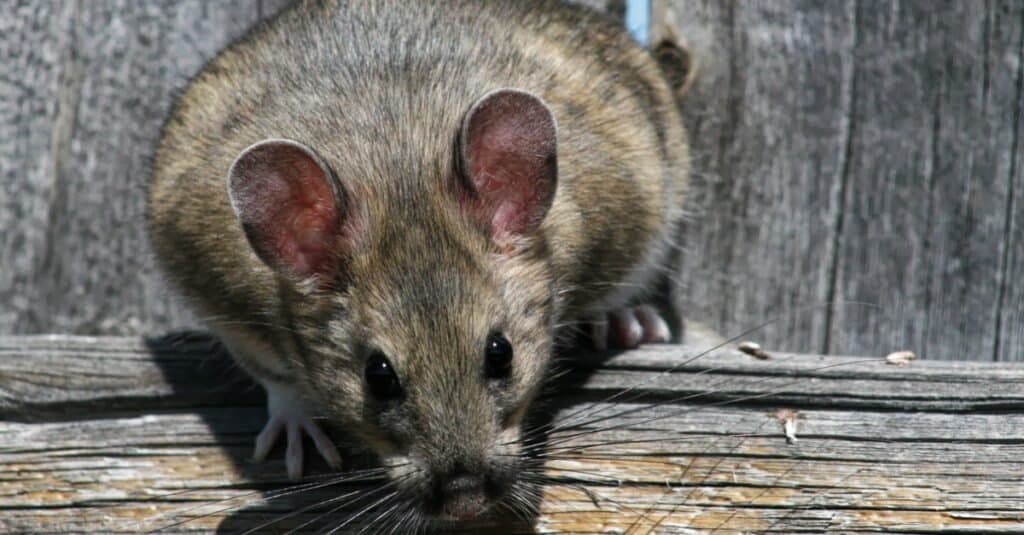
Eastern woodrats build large nests with sticks and anything shiny they can find.
©iStock.com/M. Leonard Photography
Meet the Eastern woodrat, nature’s architect. Scurrying around with its tiny paws, this rat is always on the lookout for nest-building materials.
The nests of Eastern woodrats are hard to miss. Made out of sticks, these nests can tower over a foot in height and width. If you see shiny man-made objects in the sticks, you can be certain you’re looking at a woodrat’s nest. These rodents are obsessed with anything that sparkles or shines.
Perhaps you’ll see a woodrat on its hunt for sticks and treasure. These crafty critters have gray-brown or rusty brown fur on their backs, a white belly, and whitish paws. They also have long whiskers, large ears, and a well-furred tail nearly as long as their body. Male woodrats are slightly larger than females, with a weight ranging from 119.5 to 306.4 grams (males) and 104 to 268.8 grams (females).
Northern Saw-Whet Owl
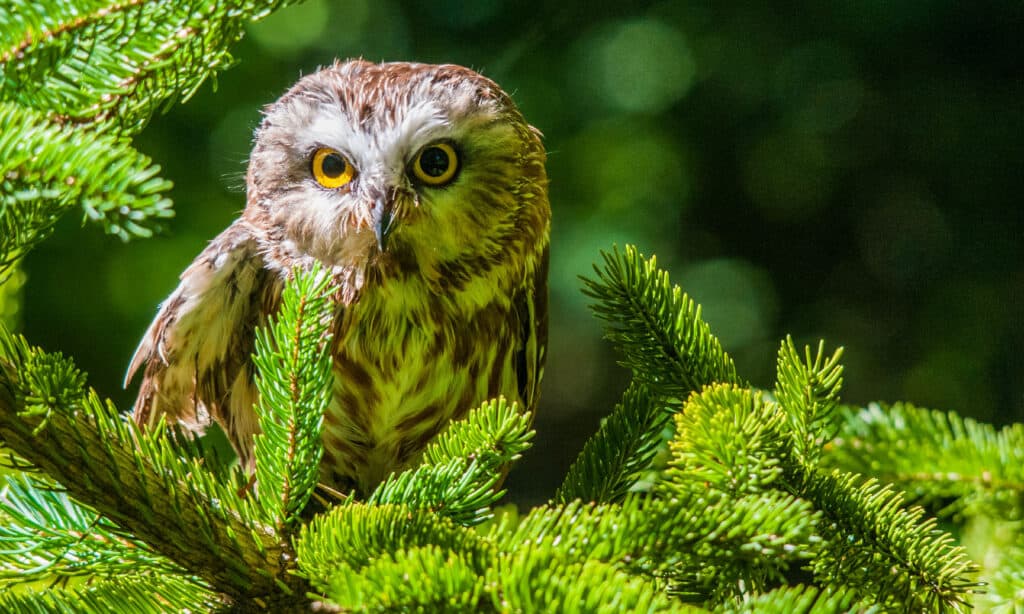
Northern saw-whet owls live throughout much of North America.
©iStock.com/bookguy
Would you like to see the smallest owl in Eastern North America? Then keep your eyes open for the tiny northern saw-whet owl. This owl is mostly nocturnal but can occasionally be diurnal. It catches its prey with its feet and swallows it in chunks, starting with the head.
The northern saw-whet owls live throughout much of North America, from southeast Alaska and the Queen Charlotte Islands in the west to Newfoundland in the east. Some refer to this species as the Queen Charlotte Owl. It’s also found as far south as Arizona and North Carolina and even in mountainous regions in central Mexico. These little owls primarily inhabit coniferous forests but can also be found in wooded riparian areas, swamps, and bogs.
To spot a northern saw-whet owl, go into the forest at night and use a spotlight to locate a calling bird. Males produce monotonous whistles; females sound softer and less consistent. Listen for yourself. Here’s an audio clip of the northern sawwhet owl.
Remember to avoid scaring or angering the owl. This species is known for being more tolerant of humans than other owls, so the chances of getting an up-close look are good. Just be sure to proceed with caution and respect.
Big-Eared Bat
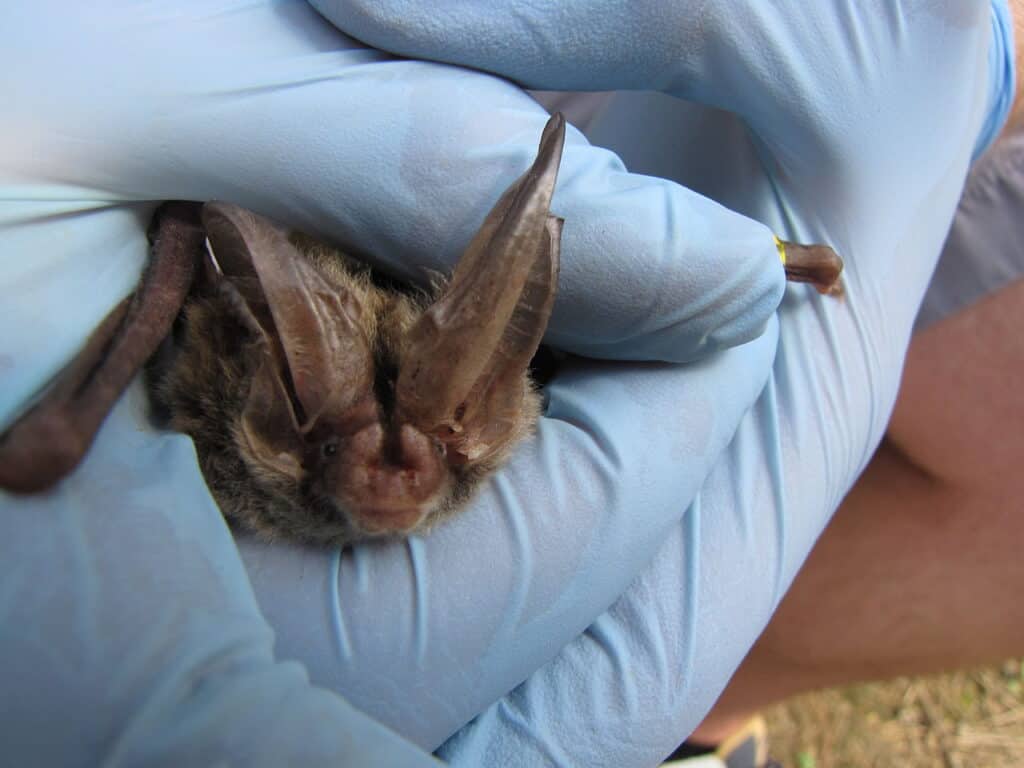
Mount Mitchell is home to Rafinesque’s big-eared bats, who love eating moths.
©CSJordan / CC BY 3.0 – License
Rafinesque’s big-eared bats have ears measuring 27-37mm in length. The large ears resemble a ram’s horns when curved backward. You can find these critters flying throughout the southeastern part of the U.S. There are two subspecies in North Carolina: C.r. macrotis in coastal plains and C.r. rafinesquii in the mountains.
When will you most likely see a big-eared bat flying around North Carolina’s tallest mountain? Since they’re nocturnal, you’ll have to wait for the sun to begin setting. That’s when they take to the sky for tasty moths to eat.
These skilled flyers can skim insects from foliage mid-flight. Their broad, short wings and lower-pitched feeding calls help them feed in dense vegetation. When it’s time to retire, they roost in caves, hollow trees, abandoned buildings, and wells.
Hellbender

Eastern hellbenders can weigh over 3 pounds, and grow over 2 feet long.
©iStock.com/JasonOndreicka
North Carolina is home to more than 65 species of salamanders, with over 50 species in the mountain region alone. The gigantic eastern hellbender is one of the most famous ones wandering around North Carolina’s tallest mountain.
The hellbender is one of only three giant salamanders found in the world. On average, adult hellbenders are 16 to 17 inches long but can grow to be more than 2 feet long and weigh over 3 pounds. Local names for hellbenders include water dog, mud puppy, devil dog, snot otter, or Alleghany alligator.
The eastern hellbender is one of the largest salamanders in North Carolina and the United States. And while their size can be intimidating, you don’t have anything to worry about. Hellbenders aren’t venomous or aggressive.
What do these salamanders eat to grow so large? Hellbenders primarily feed on crayfish but may occasionally eat fish or scavenge for dead animals. They’re primarily nocturnal and rely on touch and smell to catch food, although their eyesight is decent too.
Spruce-Fir Moss Spider
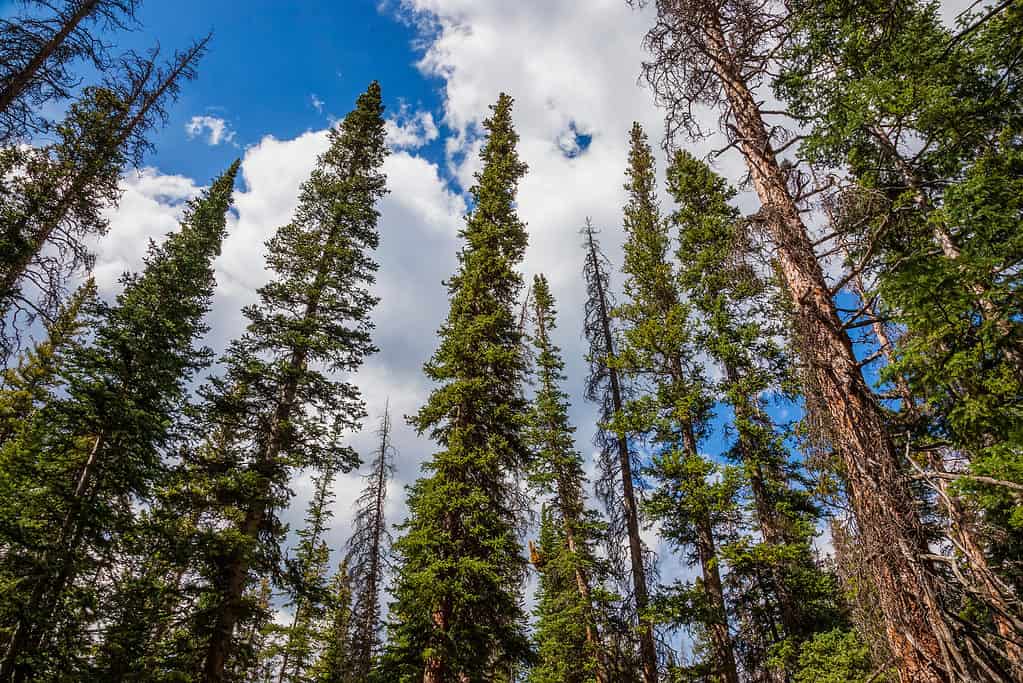
The Fraser firs along the southern Appalachians are home to the endangered spruce-fir moss spider.
©Igor Kovalenko/Shutterstock.com
The spruce-fir moss spider, one of America’s smallest endangered species, lives around Mount Mitchell. This tiny spider is about the size of a pencil eraser.
The spruce-fir moss spider’s habitat exists on less than 25 mountain tops in six areas of the southern Appalachian region. The habitat is separated by lower-elevation forests that the spider cannot use. These areas are called sky islands because they are isolated and have unique climates and landscapes.
The high-elevation conifer forests that the spider depends on were greatly reduced in the past due to logging and wildfires. Acid precipitation and an invasive insect called the balsam woolly adelgid have also taken a toll. Thankfully, efforts are being made to restore and expand the red spruce forests through initiatives like the Southern Appalachian Spruce Restoration Initiative.
Locating these tiny spiders is a delicate process. This spider is only found in a limited range, beneath mosses and liverworts growing on boulders under Fraser firs and red spruce trees. Tracking them involves carefully lifting the mats of moss where they reside.
After locating their homes, researchers can gather important data on the spruce-fir moss spider’s population status. Careful monitoring protocols help researchers track the spider species’ well-being without hurting their habitat.
Planning Your Journey to the Peak

Mount Mitchell offers hiking, camping, picnicking, and wildlife viewing opportunities.
©GaudiLab/Shutterstock.com
Check the weather before embarking on your hike. The North Carolina High Peaks Trail Association provides up-to-date weather readings from the top of Mount Mitchell. The mountain sits within the 1,855-acre state park. The park is separate from the Blue Ridge Parkway but can be accessed by taking NC 128 at Milepost 355.4.
Plan to spend at least a few hours there to take in all the sights. Many travelers on the Blue Ridge Parkway stop at Mount Mitchell to enjoy the stunning views and unique climate. There are also plenty of activities, including camping, hiking, picnicking, and wildlife viewing.
There’s No Shuttle Service
If you’re planning a hiking trip to Mount Mitchell State Park, it’s important to know that the park doesn’t offer any shuttle services or transportation for hikers. But don’t worry; there’s still a way to get there! To arrange transportation, you can call the Yancey County Transit Authority. They can help you pre-book transportation to Mount Mitchell. Let them know when you plan to visit, and they’ll assist you in arranging a ride.
How to Gain Access
Access to Mount Mitchell State Park is available via a scenic drive on the Blue Ridge Parkway. The park recommends allowing plenty of driving time, especially on weekends when traffic can be slower. It’s easy to visit since the park is open year-round. The only exception is when the roads are covered in snow and ice. Winter access is available by taking the parkway south from NC Highway 80.
Observation Deck
At the state park, a short paved trail (1/4 mile) leads to the observation deck at the summit of Mount Mitchell, providing 360-degree panoramic views. You’ll be surrounded by the spruce-fir forests of the Appalachian Mountains, including the Pisgah National Forest and the Fraser fir forest.
Camping at North Carolina’s Tallest Mountain
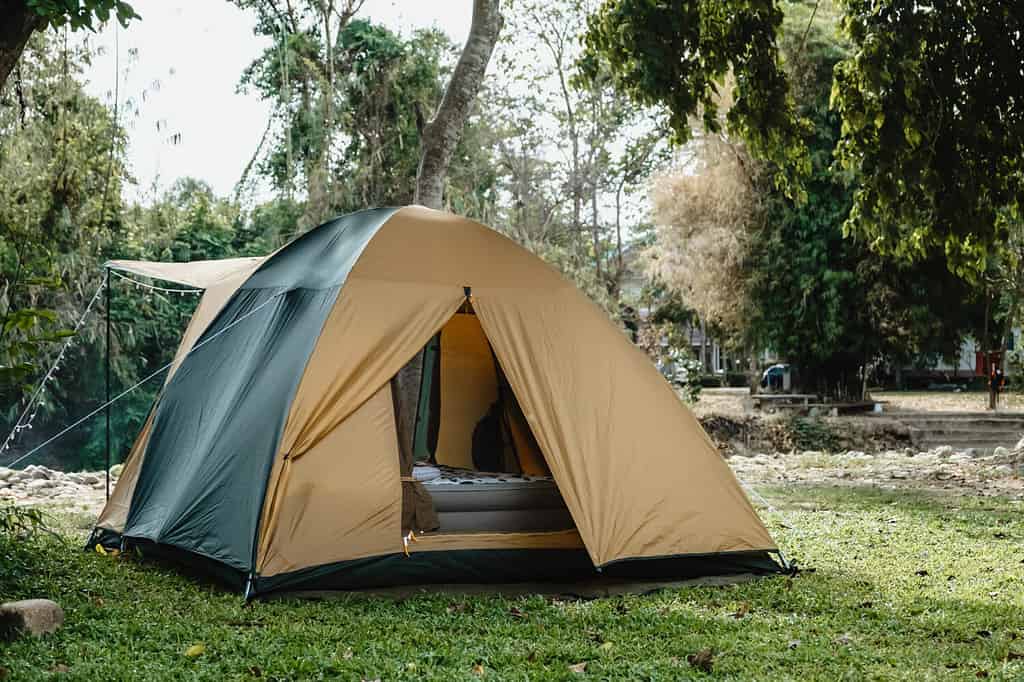
For the best wildlife viewing opportunities, camp at North Carolina’s tallest mountain.
©Mut Hardman/Shutterstock.com
For the best wildlife viewing opportunities, stay the night at North Carolina’s tallest mountain. From May to October, visitors can enjoy the Natural History Museum, a restaurant, a gift shop, and camping facilities within the park.
North Carolina State Parks manage camping reservations for Mount Mitchell. The park has a total of nine campsites available. You can check out this map to see how the sites are laid out. The nine sites are walk-in backpack campsites. That means you’ll need to carry your equipment and supplies a short distance from the parking area. Each campsite can accommodate up to 6 people. There’s a tent pad, grill, and picnic table.
If you plan to hike to backcountry tent campsites in the Pisgah National Forest, you usually can leave your vehicle overnight at the park. Check with park officials for the most up-to-date protocol. Remember to register using the forms provided at the trailheads or park office, leaving them on the car dashboard. And be sure to follow “Leave No Trace” principles. That means you only camp in designated areas, burn woods and coals to ash, and keep pets on a leash.
Bear Reports Around Mount Mitchell
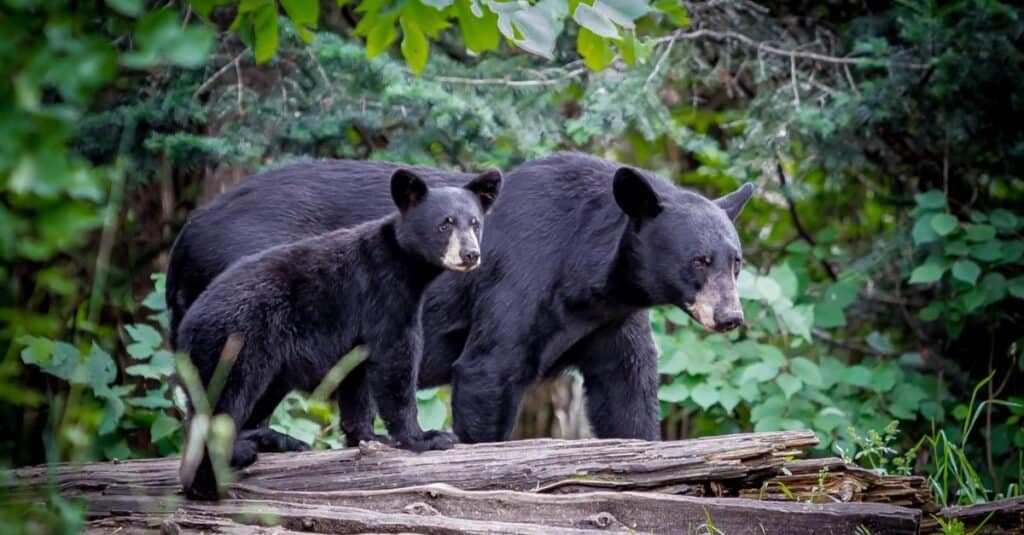
Black bears are the only bear species that live in North Carolina.
©jo Crebbin/Shutterstock.com
There are three species of bears in North America, but only one of them lives in North Carolina: the black bear. Black bears love roaming the lush forests surrounding Mount Mitchell, favoring some spots more than others. The Deep Gap area in the Pisgah National Forest has experienced multiple bear encounters recently.
Although bears generally leave people alone, there can be problems if they want something campers have, like food. Black bears are opportunistic feeders; they’ll eat almost anything that smells tasty, which means they’re particularly interested in human food and garbage.
Bear Safety
Stay safe out there. Store trash and food properly by using bear-proof containers. You should also keep highly scented items in vehicles and never leave food unattended.
Wildlife experts recommend fighting back and acting aggressively in the unlikely case of a black bear attack. Carrying bear spray registered by the Environmental Protection Agency can also be helpful for self-defense.
North Carolina Wildlife Website
Ever have questions about animals and how to interact with them? There are a lot of answers about animal interactions on ncwildlife.org. For instance, they have tips on how to stay safe around the state’s snakes and coyotes.
Snake Encounters
Snakes pose little threat if left undisturbed and typically retreat when given the opportunity. In fact, most snakebites occur when humans attempt to handle or kill snakes. Plus, killing certain snake species can be illegal. Instead, watch for slithering snakes so you can give them their well-deserved space.
Coyote Sightings
Did you hear a yip or howl? You might be in coyote territory. Coyotes generally avoid human interaction, but you should still exercise caution. Keep dogs, especially small breeds, on leashes. Shouting, waving, or throwing small objects can deter curious coyotes.
The photo featured at the top of this post is © iStock.com/Frederik Flagstad
Thank you for reading! Have some feedback for us? Contact the AZ Animals editorial team.






